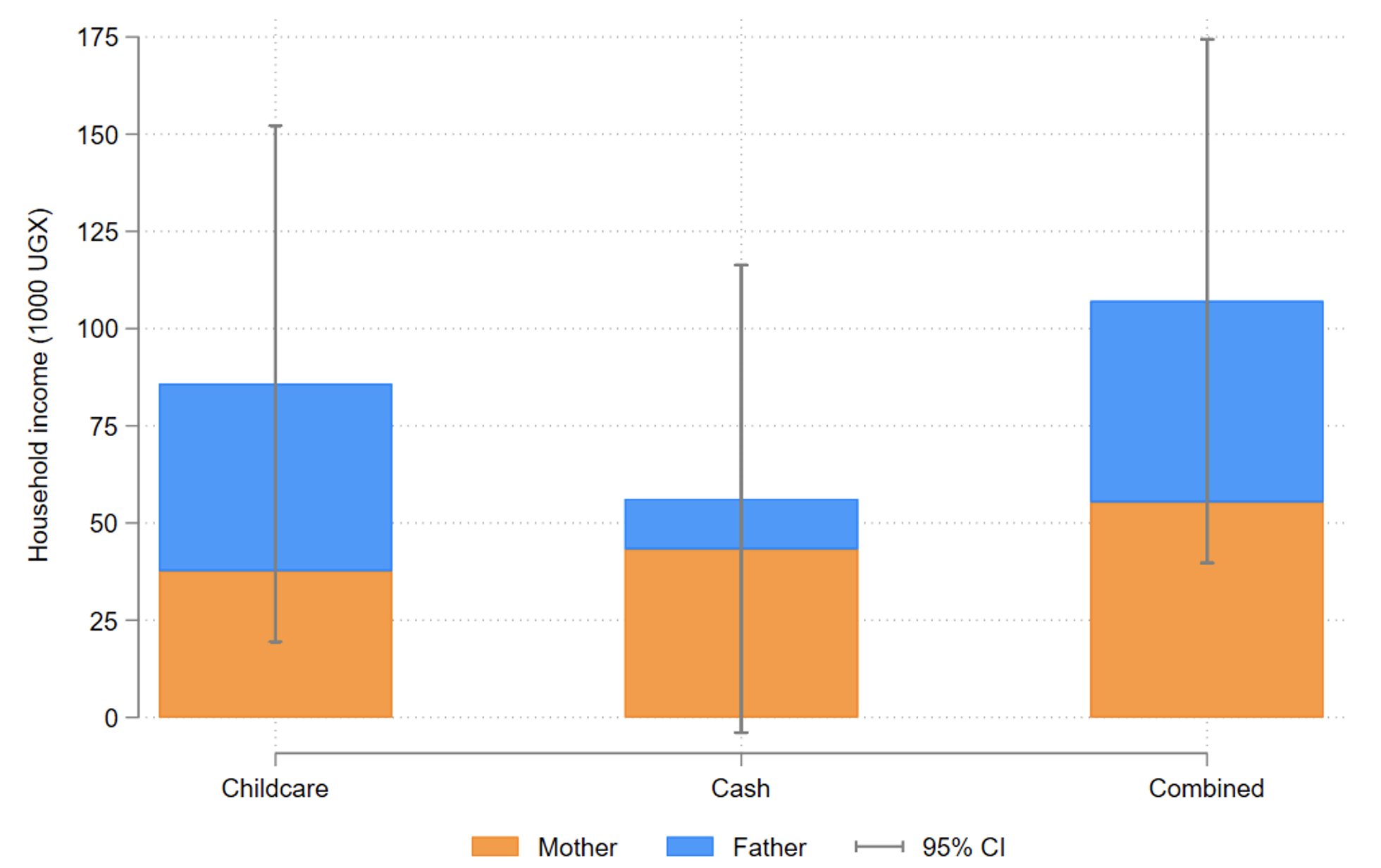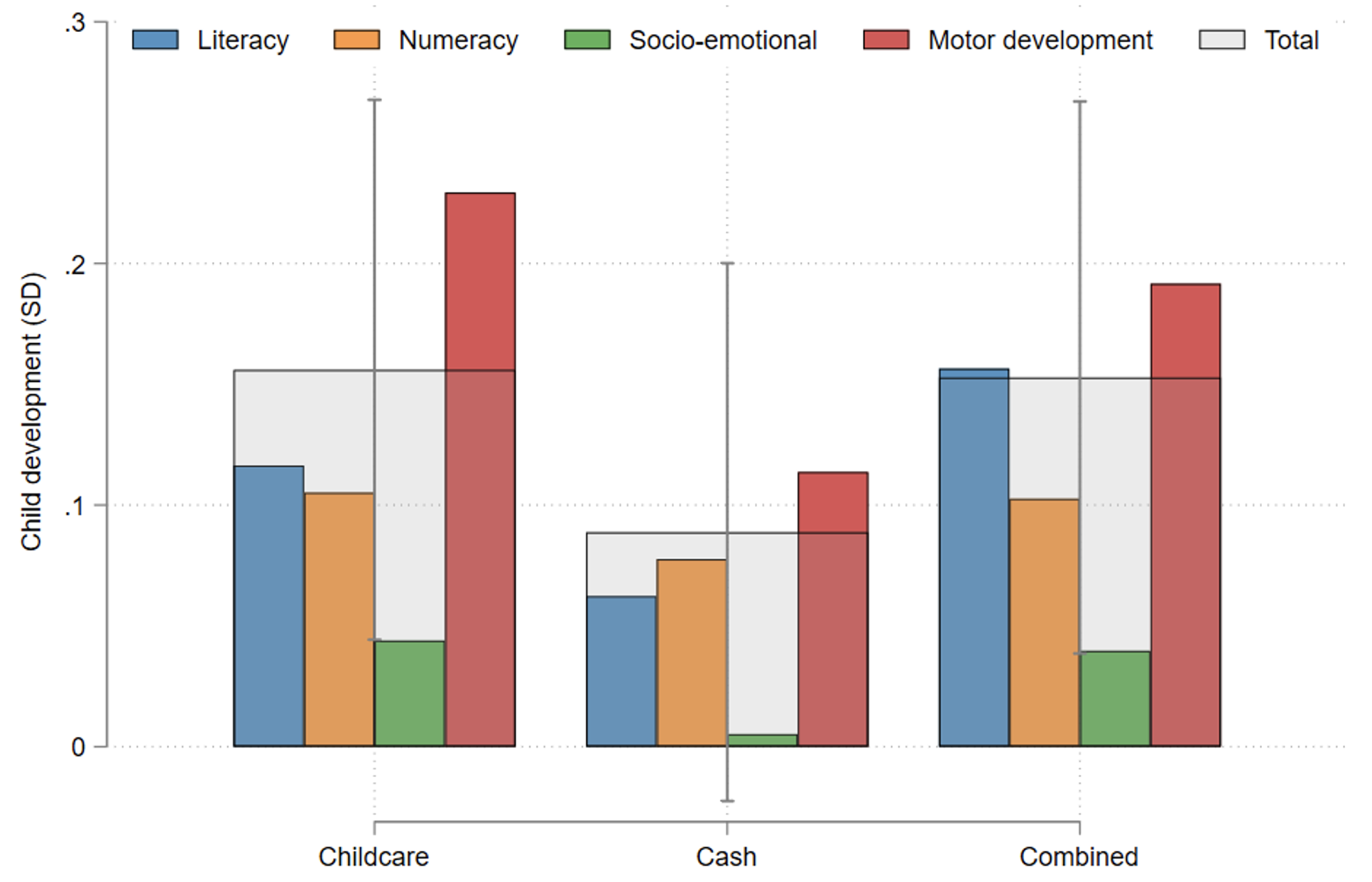
Subsidised childcare services are at least as effective as cash grants in increasing household income
Access to childcare is critical for increasing women's labour force participation in high-income countries (Baker et al. 2008, Gelbach 2002, Goldin 2021), but it is unclear if these lessons carry over to a low-income context where multiple market imperfections and social norms may limit women's labour market opportunities. In a recent paper (Bjorvatn, Ferris, Gulesci, Nasgowitz, Somville and Vandewalle 2022), we present findings from a field experiment that we designed and implemented in Uganda to understand the impact of free childcare on the mother’s business development and labour supply. We add to existing literature by also considering the impact of childcare on the labour supply of other household members, as well as a range of outcomes related to family welfare, including child development (Evans et al. 2021).
Childcare or cash, or both?
In Uganda, as in many other low-income contexts, self-employment is the dominant source of income. Starting up or expanding a business may be hampered by credit constraints and labour supply may be constrained by domestic duties, such as childcare. Moreover, there may be important complementarities between capital and labour. For instance, lack of capital may severely limit the returns to childcare as the marginal product of labour can be very low. Similarly, the returns to an increase in capital may be contingent on having access to childcare, allowing the entrepreneur to work more hours in the business.
To study these mechanisms, we randomly assigned the women in our sample of almost 1500 households to one of four groups. The first group was offered free childcare for one year. While private childcare services exist in urban and peri-urban regions of Uganda, these are typically not accessible to the poor, or are limited to a program that runs only in the morning. The childcare treatment offered parents to enrol one child aged 3-5 years in a nearby childcare centre of choice, covering the costs for tuition, breakfast and lunch. The second group was offered an unconditional cash grant equal to the cost of the childcare treatment. The cash grants were unconditional but labelled as a business grant and transferred directly to the women. The third group was offered both free childcare and the cash grant. A final and fourth group of women served as a control. We surveyed the participants at baseline and approximately one year later to measure the labour supply and earnings of the women and other household members. We also collected information on child development indicators of the ‘target child’ eligible for the childcare treatment.
The experimental design allows us to assess the relative importance of time and credit constraints for labour supply and business development, as well as the cost-effectiveness of subsidised childcare. A key contribution from this is the illustration of a comprehensive picture of the household dynamics resulting from the different treatments, including the labour market outcomes of the mother’s partner. In addition, we capture treatment effects across a broad range of outcomes related to family well-being, such as child development, happiness, stress and domestic violence. This is crucial to obtain a more thorough understanding of the potential effects of providing access to childcare.
The implementation of treatments started in February 2019 and was completed in December 2019 (one school year). A childhood development survey was conducted in December 2019, using the IDELA tool developed by ‘Save the Children‘, while a full business and household follow-up survey was conducted in February 2020, right before the COVID-19 lockdown.
Childcare’s positive impact on household income is similar to that of a cash grant
We measure household income by summing wages and revenues from self-employment for the mother and her partner – whom we shall refer to as 'the father'. We observe that the childcare intervention caused an increase in household income of UGX 86,000 (Uganda shillings equivalent to 23 USD), a 34% increase relative to the control group average. The effect is at least as large as that of a cash grant, framed as business support. We do not find any complementarity between the childcare and cash treatments on household income. While the point estimate of the combined treatment is larger than that of the single-arm treatment, the difference is not statistically significant.
Figure 1 Treatment effects on the income of mothers and fathers

Note: The figure measures average increases in income (in 1000 Uganda shillings) for the three treated groups, relative to the control group, where the mother’s income is the lower part of the bar (orange) and the father’s income is the upper part (blue). The whiskers indicate the 95% confidence interval for the treatment effects on the income of both mothers and fathers.
Childcare allows fathers to work more
Perhaps surprisingly, we find that childcare increases the father's labour supply and earnings from wage labour. We argue that this can take place either directly, by relieving time he would otherwise have spent with the child, or indirectly, by the mother taking over some of his domestic work. In fact, a recent national time-use survey shows that Ugandan men spend about five hours per day doing unpaid care work. Although this is less than the seven hours women spend on such tasks, it is still substantial. Given that men typically earn more than women in the labour market, from a household perspective it may be more lucrative to use the freed-up time from childcare to expand the father’s labour supply. For the cash treatment we do not find any effect on the father’s labor supply, while the combined treatment leads to a similar impact on the father’s labor supply as childcare only, with the increased number of work hours now equally divided between self-employment and wage labor.
Stronger effects for single mothers and for those without a younger child
The effects of childcare for the mother’s labour supply are likely to be heterogenous. If lack of time is a binding constraint for the mother's labour supply, we expect a stronger effect of childcare for those who do not have younger children to care for. Single mothers are also expected to react differently to the childcare subsidy than mothers living with a partner. Our findings support these conjectures. Childcare leads to significantly higher business revenues for mothers without younger children than for mothers with younger children and, similarly, for single mothers than for women living with a partner.
Impact on children’s development
We measure children’s development by IDELA, an instrument developed by NGO ‘Save the Children’. The tool consists of a set of questions and tests aimed at measuring the level of competency that children possess across four domains: motor skills, early literacy, early numeracy and socio-emotional skills.
As shown in Figure 2, the childcare subsidy leads to an improvement in early literacy and motor skills. While the point estimates are positive (and probably driven by the fact that some households spent the cash on sending their children to childcare), the cash grants do not have a significant effect on children's development. The impact of the combined treatment is similar to that of childcare alone.
Figure 2 Treatment effects on child development

Note: The figure shows improvements in childhood development (in standard deviations) for the treated groups, relative to the control group. The bars measure the different dimensions of the childhood development: literacy (blue); numeracy (orange); socio-emotional development (green); and motor development (red). The grey box shows a development index consisting of all dimensions, while the whiskers indicate the 95% confidence interval for the treatment effects on this index.
Conclusion
Our findings indicate that subsidising childcare can be a cost-effective way to improve household income. The positive effect of childcare on household income is at least as large as that of a cash grant of equivalent cost. Our results imply that evaluating the returns to childcare by studying its impact on child development and maternal labour outcomes is likely to underestimate the returns given the effects on the father’s labour supply and income.
Editors’ note: This article is based on this PEDL research.
References
Baker, M, J Gruber, and K Milligan (2008), “Universal Child Care, Maternal Labor Supply, and Family Wellbeing”, Journal of Political Economy 116: (4) 709-745.
Bjorvatn, K, D Ferris, S Gulesci, A Nasgowitz, V Somville, and L Vandewalle (2022), “Childcare, labor supply, and business development: Experimental evidence from Uganda”, CEPR Discussion Paper 17243.
Evans, D K, P Jakiela, and H A Knauer (2021), “The impact of early childhood interventions on mothers”, Science 372: (6544) 794–796.
Gelbach, J B (2002), “Public Schooling for Young Children and Maternal Labor Supply”, American Economic Review 92: (1) 307-322.
Goldin, C (2021), Career and Family: Women’s Century-Long Journey toward Equity, Princeton University Press.






